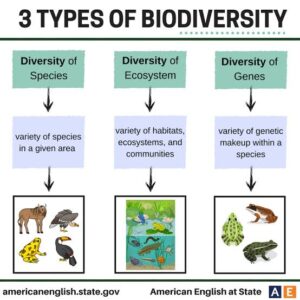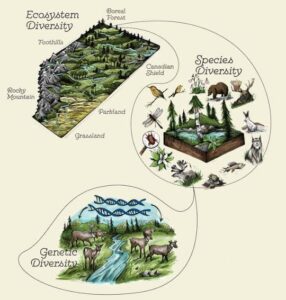Back to: Botany 500 Level
My Afrilearn star, how far? I hope say you dey shine bright today! You dey make this journey so sweet with the way you dey tackle every topic like Naija’s finest. Today, we go talk about something wey dey super important for every living thing on Earth—Biodiversity Levels. We go explore the different layers of biodiversity wey make the world so rich and full of life. Ready? Let’s go!
Biodiversity levels: genetic, species, ecosystem
What Is Biodiversity?
Biodiversity na the total variety of life wey dey on Earth. E no only mean plants and animals, but also the microorganisms wey dey everywhere, even those wey we no fit see with our eyes. Biodiversity dey happen at different levels, and today, we go talk about three major levels: genetic diversity, species diversity, and ecosystem diversity. Each of these levels dey important in maintaining life as we know it.

- Genetic Diversity
Genetic diversity refers to the variety of genes within a species. Think of it like the different “DNA” wey each living thing carries. Just like how you and your siblings fit have some similar features (like your father’s smile), but you all still dey unique in your own way, genetic diversity makes sure that no two individuals are exactly the same—even within the same species.
Why e dey important?
Genetic diversity helps species adapt to changes in the environment. For example, if a disease attacks one species, genetic diversity means that some individuals may have genes that help them survive. This helps the whole species stay strong over time. It also helps in breeding, so species don’t go extinct due to inbreeding or lack of variety in their gene pool.
Example:
Look at yam varieties in Nigeria. Some yams are more resistant to drought, others to pests, and some grow faster. This genetic diversity ensures that no matter what challenge comes, we still fit harvest good crops.
- Species Diversity
Next up, we get species diversity. This one refers to the variety of species that exist in an ecosystem or on the planet. It’s about how many different species of plants, animals, and microorganisms dey in a particular place. Each species plays a unique role in its ecosystem—whether na as a predator, prey, or even a pollinator.
Why e dey important?
Species diversity helps maintain balance in ecosystems. Each species helps to keep the system healthy by contributing to the food web, pollination, soil fertilisation, and even controlling pests. The more species we get, the more stable the ecosystem.

Example:
In a forest, you get different species of trees, insects, birds, and other animals. These species work together. For instance, bees pollinate flowers, while trees provide shelter for birds, and the leaves that fall from trees decompose and add nutrients to the soil. All these species depend on each other to survive and thrive.
- Ecosystem Diversity
Now, let’s talk about ecosystem diversity. This refers to the variety of habitats, communities, and ecological processes that happen across the Earth. From forests to deserts, oceans to wetlands, every ecosystem supports different species and has unique environmental conditions that shape how life thrives.
Why e dey important?
Ecosystem diversity ensures that different species can find a suitable place to live. It also contributes to climate regulation, water purification, and carbon storage. The variety of ecosystems helps ensure that life can survive even in harsh conditions.
Example:
Nigeria gets different ecosystems—rainforests, savannas, mangroves, and even the desert-like areas in the north. Each of these ecosystems provides a home for unique plants and animals. For instance, the mangrove swamp in the coastal areas provides a home for crabs, fish, and birds, while the savanna supports animals like lions, elephants, and various grasses.
Why is Biodiversity So Important?
Biodiversity dey critical for life on Earth because it supports everything we do. It provides food, medicine, clean air, water, and even raw materials for things we use every day. It also ensures that ecosystems stay healthy, which in turn supports our own well-being.

If biodiversity decreases, it can lead to ecosystem instability. For example, if we lose species that help pollinate crops, our food supply could be at risk. If we destroy ecosystems, animals may not have places to live, leading to extinction.
Summary:
- Genetic Diversity refers to the variety of genes within a species, helping them adapt to environmental changes.
- Species Diversity refers to the variety of species in an ecosystem, maintaining balance and ecosystem health.
- Ecosystem Diversity refers to the variety of ecosystems, providing different habitats and supporting various species.
- Biodiversity is important for maintaining healthy ecosystems, which in turn supports life on Earth.
Evaluation:
- What is the difference between genetic diversity and species diversity?
- Why is species diversity important for ecosystems?
- Give one example of how ecosystem diversity benefits life on Earth.
You’re an Afrilearn superstar, no doubt! You just grasped the different levels of biodiversity like a pro! E dey clear say you’re understanding how the variety of life on Earth keeps everything running smoothly. Keep up the good work—you’re making massive progress! And remember, the more you know, the more you can help protect this beautiful planet. Stay sharp, stay smart, and I’ll see you in the next lesson! You dey do well!
